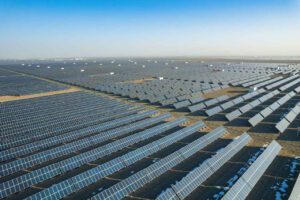Researchers at North Carolina State University (NCSU) say they’ve made a breakthrough that could realise the dream of next-generation solar cells made of perovskite, a notoriously tricky material that can absorb light more efficiently than silicon.
The team of researchers discovered that channelling ions into defined pathways with the material’s crystalline structure can improve the stability and operational performance of perovskite-based solar cells, in theory making them commercially viable.
A perovskite is any material that has the same crystalline structure as the mineral calcium titanium oxide (CaTiO₃), which was the first perovskite crystal ever discovered.
A number of different elements can be combined to form perovskite structures which have unique properties that make them perfect for use in optical, electrical and other contexts. Perovskite crystals can be found in ultrasound machines, memory chips and – in theory – solar cells.
While silicon has been the dominant semiconductor material used in solar cells for decades, perovskites have been proposed as a more efficient, cheaper to manufacture alternative to expensive and complex silicon panels. Perovskite solar cells can be thinner and lighter than silicon-based cells without sacrificing conversion efficiency.
“That opens the door to a host of new technologies, such as flexible, lightweight solar cells, or layered solar cells (known as tandems) that can be far more efficient than the solar harvesting technology used today in so-called solar farms,” explains Aram Amassian, corresponding author of the study and a professor of materials science and engineering at NCSU.
“There’s interest in integrating perovskite materials into silicon solar cell technologies, which would improve their efficiency from 25% to 40% while also making use of existing infrastructure.”
In 2012, researchers first discovered how to make a stable, thin-film perovskite solar cell with conversion efficiencies of over 10%, but no one has yet seen affordable, efficient perovskite solar cells to market.
That’s because, to date, perovskite cells have proved tricky to manufacture with long-term stability.
Because perovskites are ionic, when a voltage is applied to the material it causes the ions to migrate through the material, which researchers believe contributes to chemical and structural changes in the material that ultimately make it hopeless as a semiconductor.
To make commercially viable perovskite cells, researchers have to find a way to address this problem. What the NCSU team have discovered is that rather than preventing ions from moving at all, they can corral them through safe channels in the structure without damaging its integrity.
“It’s a big step forward,” Amassian says.
That safe channel is known as a grain boundary. Because perovskites are multi-crystalline materials, they are composed of a series of crystals – or ‘grains’, like in wood – that are flush with one another.
These grains are what absorbs the incoming light and generates electrical charges. Each grain has the same crystalline structure but the grains may be oriented in different directions: where the grains touch is known as a grain boundary.
“What we’ve found is that grains are better protected from impairment when the ions move predominantly along the grain boundary,” says first author Masoud Ghasemi, a former postdoctoral researcher at NCSU now affiliated with Penn State.
“Coupling this with what is already known about perovskite materials, it’s clear that problems start when grain boundaries are weak, which makes it easier for ions to move into the grains themselves.
“Designing stronger grain boundaries that protect the grains is essential to block migrating ions and other harmful species like oxygen from entering the grains, mitigating problematic chemical and structural changes in the material.”
Amassian says that, armed with this new knowledge, scientists can deliberately engineer perovskite materials with stronger grain boundaries. Techniques for doing so are demonstrated in the new study.
The researchers hope that this discovery could also inform the development of more efficient energy storage techniques.
“This work advances our fundamental understanding of how ions move through any crystalline material that can carry charge, not just halide perovskites,” Amassian says. “We’re excited to talk to colleagues who work on energy storage about how this may inform the engineering of faster ion conductors.”
The paper, A multiscale ion diffusion framework sheds light on the diffusion–stability–hysteresis nexus in metal halide perovskites, was published yesterday in Nature Materials, and was supported by the US Office of Naval Research, the US National Science Foundation, and the US Department of Energy.










